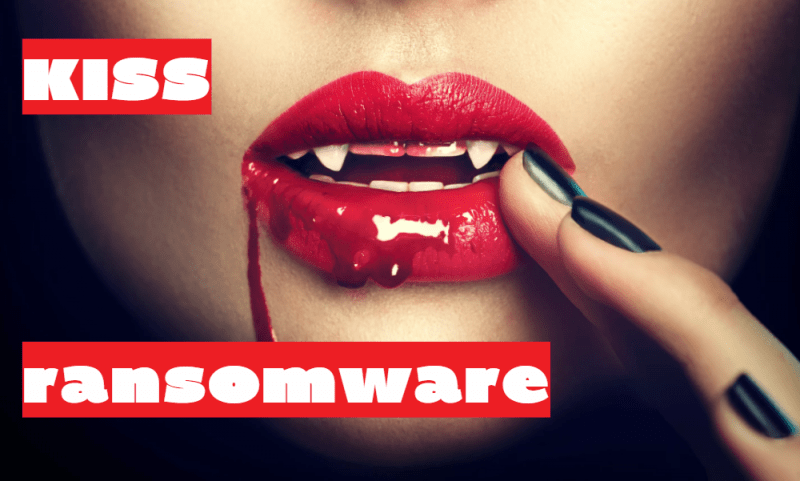What is Kiss Ransomware
Kiss ransomware is the next version of cryptoviruses aimed at encrypting user files (photos, videos, audio and much more) and extorting money from users. After penetration, Kiss ransomware encrypts user files using a multi-stage algorithm, which makes them inoperative. Also, besides this, Kiss ransomware changes the extension of these files to .kiss. In particular, the longer compound extension _id-(user-id)_._decodor_airmail.cc_.kiss is added to the files.

Speaking about the distribution of Kiss ransomware itself, it is worth saying that Kiss ransomware appeared in mid-October 2019. In a short time, Kiss ransomware has spread to almost all corners of the globe. Conventional methods do not help decrypt files, including the usual renaming of files. Kiss ransomware creates a scam note file that contains the following information:

To put it mildly, the note is not very informative. According to our data, after contacting the cybercriminals, they demand a ransom, the amount of which can vary from a few hundred dollars to several thousand US dollars. Of course, we categorically don’t recommend you pay, ’cause there is no guarantee that your files will be truly decrypted. Use our recommendations to remove Kiss ransomware and decrypt .kiss files.
Well, there are 2 options for solving this problem. The first is to use an automatic removal utility that will remove the threat and all instances related to it. Moreover, it will save you time. Or you can use the Manual Removal Guide, but you should know that it might be very difficult to remove Kiss ransomware manually without a specialist’s help.
Kiss Removal Guide

Remember that you need to remove Kiss Ransomware first and foremost to prevent further encryption of your files before the state of your data becomes totally useless. And only after that, you can start recovering your files. Removal must be performed according to the following steps:
- Download Kiss Removal Tool.
- Remove Kiss from Windows (7, 8, 8.1, Vista, XP, 10) or Mac OS (Run system in Safe Mode).
- Restore .Kiss files
- How to protect PC from future infections.
How to remove Kiss ransomware automatically:
Thor Home may help you to get rid of this virus and clean up your system. In case you need a proper and reliable antivirus, we recommend you to try it.

Alternative solution – Malwarebytes
This program will find malicious files, hijackers, adware, potentially unwanted programs and will neutralize it. Also, Norton will help you clean your system properly.
If you’re Mac user – use this.
Manual Kiss Removal Guide
Here are step-by-step instructions to remove Kiss from Windows and Mac computers. Follow these steps carefully and remove files and folders belonging to Kiss. First of all, you need to run the system in a Safe Mode. Then find and remove needed files and folders.
Uninstall Kiss from Windows or Mac
Here you may find the list of confirmed related to the ransomware files and registry keys. You should delete them in order to remove virus, however it would be easier to do it with our automatic removal tool. The list:
Kiss.dll
_readme.txt
readme.txt
Windows 7/Vista:
- Restart the computer;
- Press Settings button;
- Choose Safe Mode;
- Find programs or files potentially related to Kiss by using Removal Tool;
- Delete found files;
Windows 8/8.1:
- Restart the computer;
- Press Settings button;
- Choose Safe Mode;
- Find programs or files potentially related to Kiss by using Removal Tool;
- Delete found files;
Windows 10:
- Restart the computer;
- Press Settings button;
- Choose Safe Mode;
- Find programs or files potentially related to Kiss by using Removal Tool;
- Delete found files;
Windows XP:
- Restart the computer;
- Press Settings button;
- Choose Safe Mode;
- Find programs or files potentially related to Kiss by using Removal Tool;
- Delete found files;
Mac OS:
- Restart the computer;
- Press and Hold Shift button, before system will be loaded;
- Release Shift button, when Apple logo appears;
- Find programs or files potentially related to Kiss by using Removal Tool;
- Delete found files;
How to restore encrypted files
You can try to restore your files with special tools. You may find more detailed info on data recovery software in this article – recovery software. These programs may help you to restore files that were infected and encrypted by ransomware.
Restore data with Stellar Data Recovery
Stellar Data Recovery is able to find and restore different types of encrypted files, including removed emails.
- Download and install Stellar Data Recovery
- Choose drives and folders with your data, then press Scan.
- Select all the files in a folder, then click on Restore button.
- Manage export location. That’s it!
Restore encrypted files using Recuva
There is an alternative program, that may help you to recover files – Recuva.
- Run the Recuva;
- Follow instructions and wait until scan process ends;
- Find needed files, mark them and Press Recover button;
How to prevent ransomware infection?
It is always rewarding to prevent ransomware infection because of the consequences it may bring. There are a lot of difficulties in resolving issues with encoders viruses, that’s why it is very vital to keep a proper and reliable anti-ransomware software on your computer. In case you don’t have any, here you may find some of the best offers in order to protect your PC from disastrous viruses.
Malwarebytes
SpyHunter is a reliable antimalware removal tool application, that is able to protect your PC and prevent the infection from the start. The program is designed to be user-friendly and multi-functional.

